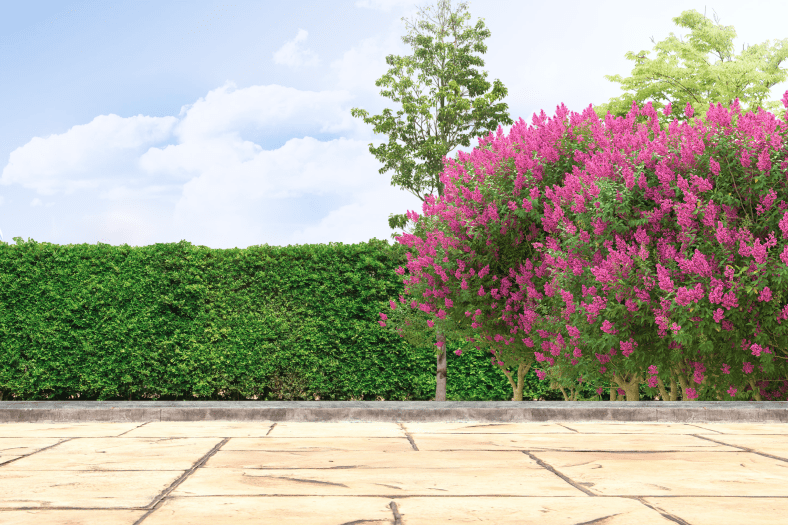
Who doesn’t love being around green spaces and fresh air? Shrubs and trees are a great way to brighten up your environment and to capture carbon from the air.
Carbon dioxide is one of the main greenhouse gases responsible for climate change. Trees and shrubs can help to reduce the amount of carbon dioxide in the atmosphere by capturing it and storing it in their leaves, branches, and trunk. In this way, they act as a natural filter for the surrounding air. Not only do they help to improve the air quality, but they also help to combat climate change.
Outdoor plants are a great way to spruce up your home’s curb appeal. They can also provide privacy, shade, and protection from the elements. When choosing outdoor plants, it’s important to select varieties that are well-suited to your climate and soil type.
There are many bushes and shrubs that you can choose from to grow a live fence on your property. Below are some of the most popular options along with their key characteristics.
Ask these specialists how to choose flowers
Lilacs
Lilacs are a species of flowering plant in the olive family. The lilac is an old-fashioned favorite flower, and its name is derived from the Arabic word for “bluish.”
If you’re looking to add a pop of color to your yard, consider planting some lilacs!
Lilacs are a multi stemmed small tree or bush that can grow quite quickly. They come in a variety of shades of purple and pink, and they release a wonderful scent.
They can resist cold temperatures and need little maintenance. Plant Lilacs in either the spring or fall.
Lilacs flower profusely every other year but can have their blooming improved by deadheading the flower clusters after they fade and before seeds form.
They need to be pruned each year to keep them in a hedge shape. Prune twiggy growth on shoots that have flowered more than once or twice and cut them back to a strong, outward-growing side shoot. Also, take off any suckers that have sprouted from the bottom. You can transplant them to extend your hedge.
Cypress
Cypress shrubs are popular for living fences because they are more resistant to strong winds than Lilacs. They can also tolerate a wide range of conditions, including drought and salt spray.
While most true cypresses are trees, there are also some that are shrubs.
One of the favorite Cypress shrubs for planting a live fence with is Wilma Goldcrest It is a columnar bright-gold shrub with a defined point that grows to 8 feet tall and up to 2 feet wide.It ‘s hardy in zones 7 through 10.
Another great choice is Drew’s Blue cypress. It grows deep, bluish-green foliage on a spreading mound that reaches up to 2 feet tall and 3 feet wide. In the winter, the foliage turns an attractive maroon tint, which is absolutely stunning. It is hardy in USDA zones 2 through 8 and is a variety that handles full shade.
They are often used as foundation plants or as border plants in landscaping, but when pruned correctly they make a great live fence.
Boxwoods
Boxwoods are popular shrubs in North America because they are easy to care for and maintain. They can be used as live fences, as well as for other landscaping purposes.
There are many different cultivars and species of boxwood, and they vary in size, shape, leaf characteristics, growth rates, and hardiness.
Boxwood plants are thick, green shrubs that are usually planted in fancy and formal gardens. There are lots of different kinds of boxwood plants. People grow them for their leaves, because their flowers are not very special. You can plant a row of them to make a formal hedge, a matching border, or a pair of boxwood plants to balance an entryway. Boxwood can also be planted as focal points or foundation plantings.
Boxwood needs either a full or partial sun location for optimum growth. Successfully growing boxwood requires well-drained soil, although the plants prefer organic soil, they are adaptable.
But if temperatures become extremely hot in summer, boxwoods will do better in the afternoon shade with regular watering. Water deeply because shallow frequent waterings will not reach the root zone.
When you plant boxwood, put them where they are protected from wind in the winter to avoid a condition called winter bronzing. Plant at the same level they were planted at the nursery or in the container–planting boxwood too deeply can lead to stress and possibly death.
Privet
Privet shrubs have been used to build tall green fences for centuries because of their tough, evergreen foliage. When pruned properly, privet can grow up to 10 feet tall, making it an excellent choice for a tall green fence.
Before you think of choosing a Privet you need to be aware that it is an invasive species because it will spread if not kept in check and push out native vegetation. It is very adaptable and various species are now a problem in North America.
There are three main varieties of Privet:
- Straight Talk Privet shrub is an evergreen shrub that can grow to be up to 15 feet tall. It has dark green leaves that are oval-shaped and can be up to 4 inches long. The small and white flowers grow in clusters and produce black and glossy berries that are about 1/4 inch in diameter.
- Golden Ticket Privet shrubs are a type of ornamental shrub that is known for its unique golden-yellow leaves. These shrubs are native to China and Japan, and they are often used as ornamental plants around homes or in gardens and parks in North America. Golden Ticket shrubs can grow up to 6 feet tall and wide, and they prefer to grow in full sun to partial shade. These shrubs are low-maintenance, and they are tolerant of a variety of soil. This variety of privet is a popular choice for hedges and foundation plantings, as it stays relatively compact and does not require much pruning to maintain its shape.
- Cheyenne Common Privet shrubs are native to North America and can be found in the eastern United States and Canada. Common privet is a popular landscaping plant and is used as a hedge or privacy screen. The shrubs can grow up to 15 feet tall and have small, dark green leaves. The flowers are white and bloom in the spring. Common privet is easy to grow and is tolerant of most soil types.
Cedar
Cedar shrubs can provide an effective visual barrier between you and your neighbor’s yard.
They can also help to block out unwanted noise pollution from cars or other sources. Cedar shrubs are not only great for blocking noise pollution, but they will also give you the visual privacy you desire.
These Cedars are good for a privacy hedge:
Emerald Cedar shrubs have a conical shape and bright green foliage. When planted together, they form a row of tall privacy hedges in your yard.Emerald cedar shrubs (also referred to as arborvitae) should be planted in an area where they get a large amount of sun, and should be watered well, particularly when they are young. These privacy shrubs will grow to approximately 15 feet tall and roughly three to four feet wide at maturity.
Brabant White Cedar is a great choice for privacy fencing because of its compact growth habit. This coniferous shrub’s leaves are a vibrant yellow-green, with a fine texture and an annual growth rate of 8 to 12 inches and lives to 30 years. It is low-maintenance when it comes to pruning and will quickly create the dense, natural privacy wall you’re looking for.
Yellow Ribbon Cedar is a dense multi-stemmed evergreen shrub that is native to North America, making it a easy-to-grow option for privacy fencing because of its narrow columnar shape. It produces new growth in a golden hue that matures to green, offering year-round interest and colour. It grows to a mature height of anywhere from 8 to 10 feet tall, making them an ideal shrub to use for privacy fencing. Also, its slow growth rate makes it easy to maintain in whatever shape or size you desire.
Yew
Yew shrubs have been around for ages and are known to be long-lived plants. Yews are garden favorites because of their dense, evergreen foliage and tolerance of repeated pruning.
Yew shrubs are a great choice for low-maintenance landscaping. They are tolerant of drought and can grow in most soil types, thriving in full sun or shade.
With a little annual maintenance, you can keep these shrubs shaped into all sorts of different designs. Just be careful when planting these around small children and animals because most parts of yews are poisonous if ingested.
Hicks yew is a common choice for a living fence because it is unique and can keep your home lively without being too flashy. This shrub produces spiky green foliage that is an evergreen and will stay brightly colored all year. During the winter, Hicks yew produces red berries. It can become brown if exposed to too much winter wind.
Irish yew was discovered in County Fermanagh in 1780, and it is thought to be a mutant form of the common yew. It is an evergreen conifer which can grow to 22 feet. It has needle-like leaves which grow all around the main stem and not in rows. Each needle has a raised central vein underneath. The flowers are pollinated by wind and develop into succulent berries.
Consult our list of the best flower deliverers
Final Thoughts on Live Fences
Although there are other worthy shrubs and bushes to make a living fence from, the best plant for the job is the common boxwood.
There are several reasons why the common boxwood is the best plant for the job of creating a living fence. For one, boxwoods are very dense, which makes them excellent at providing privacy and blocking out unwanted noise. They are also evergreen, so they will keep your fence looking green and full all year round.
Additionally, boxwoods are low-maintenance shrubs, which means they don’t require a lot of care or attention. They are also drought-tolerant and grow well in North America.





